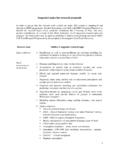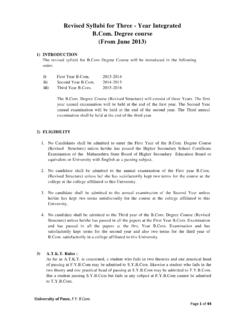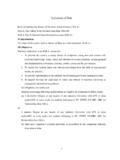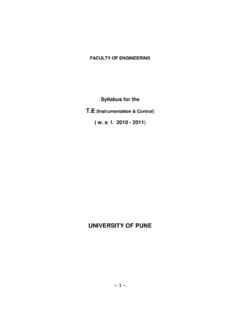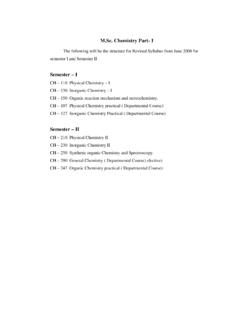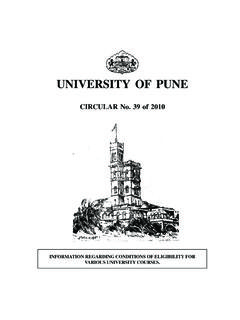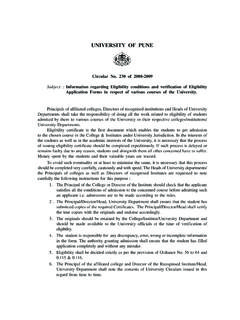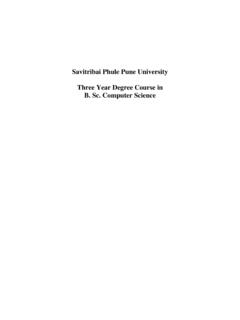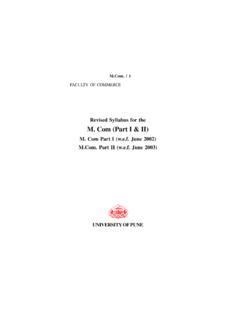Transcription of Syllabus Savitribai Phule Pune University Faculty of ...
1 Syllabus Savitribai Phule Pune University Faculty of Engineering Computer Engineering (Course 2012). ( June 2015). Board of Studies Computer Engineering June 12, 2015. Preamble It is my pleasure to present this Computer Engineering Syllabus . The Syllabus is a blend of concepts and advances using high end FOSS technologies. One of the objectives of the this Syllabus is to cultivate students for using FOSS and contributions in FOSS. The theory subjects are based on the pre-requisites covered in first year to third Year computer engineering. 16 electives are divided into four groups on recent technologies such as cloud computing, mobile computing, web applications and Business Analytic and Intelligence, Cyber Security are provided which shall be useful for student in their professional carrier.
2 The laboratories for problem solving practices are based on utilization of state-of-the art FOSS software Tech- nologies used by the Industries. The FOSS technologies are available with source code students can experiment the performance improvement and ideation to replace the existing implementation. The Project can be done as conventional practices or as an entrepreneur project to give thrust on generating budding talent as entrepreneur to lead the industrial front of the nation worldwide. For BoS Computer Engineering Prof. Sarang Joshi 1. Program Educational Objectives To create competencies and opportunities for Higher Education.
3 To create professional manpower skilled for the IT Industry;. To provide laboratory practices with advanced FOSS Tools;. To provide inter-disciplinary opportunities;. To provide opportunities of developing technical documents and presentation skills. to provide opportunities of industry-Institute interactions;. To develop opportunities to promote Entrepreneurship and start-ups;. To nurture professional and social ethics. Program Objectives To expose students to the Systems and Applications Programming, Organizations and Architectures;. To provide conceptual knowledge in the Computing domain;. To provide interdisciplinary knowledge.
4 To expose students with advanced tools used in industry;. To develop written and soft-skill competencies;. To develop team work experience of professionals skills for IT Industry. Program Outcomes To test applications with concepts and skills in the domain subjects;. To demonstrate skills in programming techniques and technologies;. To demonstrate oral and written skills for technical presentations and documentation;. To demonstrate IT project as team work;. To demonstrate social and Professional ethical practices;. 2. Savitribai Phule PUNE University . BE (COMPUTER ENGINEERING)- 2012 COURSE STRUCTURE. Term-I. Subject Subject Teaching Scheme Examination Scheme Total Code Marks Lect Tut Pract In PR/ OR/ End Sem TW TW Sem Asmnt Asmnt 410441 Design & Analysis 03 30 70 100.
5 Of Algorithms 410442 Principles of Modern 04 30 70 100. Compiler Design 410443 Smart System Design 03 30 70 100. and Applications 410444 Elective-I 03 30 70 100. 410445 Elective-II 03 30 70 100. 410446 Computer 04 50 50 100. laboratory-I. 410447 Computer 04 50 50 100. Laboratory-II. 410448 Project 02 50 50. Total 16 02 08 150 150 100 350 750. Term-II. 410449 Software Design 03 30 70 100. Methodologies &. Testing 410450 High 03 30 70 100. Performance Computing 410451 Elective-III 03 30 70 100. 410452 Elective-IV 03 30 70 100. Open Elective 410453 Computer 04 50 50 100. laboratory-III. 410454 Computer 04 50 50 100. Laboratory-IV.
6 410455 Project 06 50 100 150. Total 12 06 08 120 150 200 280 750. 3. Electives: Semester-I Semester-II. ELECTIVE-I ELECTIVE-III. 1. Image Processing 1. Mobile Computing 2. Computer Network Design 2. Web Technology and Modeling 3. Advanced Computer Programming 3. Cloud Computing 4. Data Mining Techniques 4. Cyber Security and Applications ELECTIVE-II ELECTIVE-IV (Open Elective). 1. Problem Solving with Gamification 1. Business Analytic and Intelligence 2. Pervasive Computing 2. operations research for Algorithms in Scientific Applications 3. Embedded Security 3. Mobile Applications 4. Multidisciplinary NLP 4. Open Elective Open Elective: The listed open electives or any other Elective that is being taught in the current semester (semester-II) under the Faculty of engineering or individual college and Industry can define new elective with complete (6 units) Syllabus using defined framework of Elective IV and GET IT APPROVED FROM THE.
7 BOARD OF STUDIES (COMPUTER ENGINEERING) AND OTHER NECESSARY STATUTORY SYS- TEMS IN THE Savitribai Phule PUNE University BEFORE 30th DECEMBER. 4. 410441 Design and Analysis of Algorithms Teaching Scheme Examination Scheme Lectures: 3 Hrs/ Week In semester Assessment: 30. End Semester Assessment : 70. Course Objectives: To develop problem solving abilities using mathematical theories;. To apply algorithmic strategies while solving problems;. To develop time and space efficient algorithms;. To study algorithmic examples in distributed, concurrent and parallel environments. Course Outcomes: To solve problem in the UG projects.
8 To develop SRS in the UG projects;. To solve problems for multi-core or distributed or concurrent/Parallel/Embedded environments;. Unit Content Hrs I Problem solving and Algorithmic Analysis 6. Problem solving principles: Classification of problem, problem solving strategies, classification of time complexities (linear, logarithmic etc). problem subdivision Divide and Conquer strategy. Asymptotic notations, lower bound and upper bound: Best case, worst case, average case analysis, amortized analysis. Performance analysis of basic programming constructs. Recurrences: Formulation and solving recurrence equations using Master Theorem.
9 II Greedy and Dynamic Programming Algorithmic Strategies 6. Greedy strategy: Principle, control abstraction, time analysis of control abstraction, knapsack problem, scheduling algorithms-Job scheduling and activity selection problem. Dynamic Programming: Principle, control abstraction, time analysis of control abstraction, binomial coefficients, OBST, 0/1 knapsack, Chain Matrix multiplication. III Backtracking and Branch-n-Bound 8. Backtracking: Principle, control abstraction, time analysis of control abstraction, 8-queen problem, graph coloring problem, sum of subsets problem. Branch-n-Bound: Principle, control abstraction, time analysis of control abstraction, strategies FIFO, LIFO and LC approaches, TSP, knapsack problem.
10 IV Complexity Theory 6. Overview: Turing machine, polynomial and non-polynomial problems, deterministic and non- deterministic algorithms, P class, NP class &. NP complete problems- vertex cover and 3-SAT and NP hard problem . Hamiltonian cycle. The menagerie of complexity classes of Turing degrees. Concept of randomized and approximation algorithms: Solving TSP by approximation algorithm, Randomized sort algorithms and Approximating Max Clique. V Parallel and Concurrent Algorithms 6. Parallel Algorithms: Sequential and parallel computing, RAM &. PRAM models, Amdahl's Law, Brent's theorem, parallel algorithm analysis and optimal parallel algorithms, graph problems (shortest paths and Minimum Spanning Tree, Bipartite graphs ).
